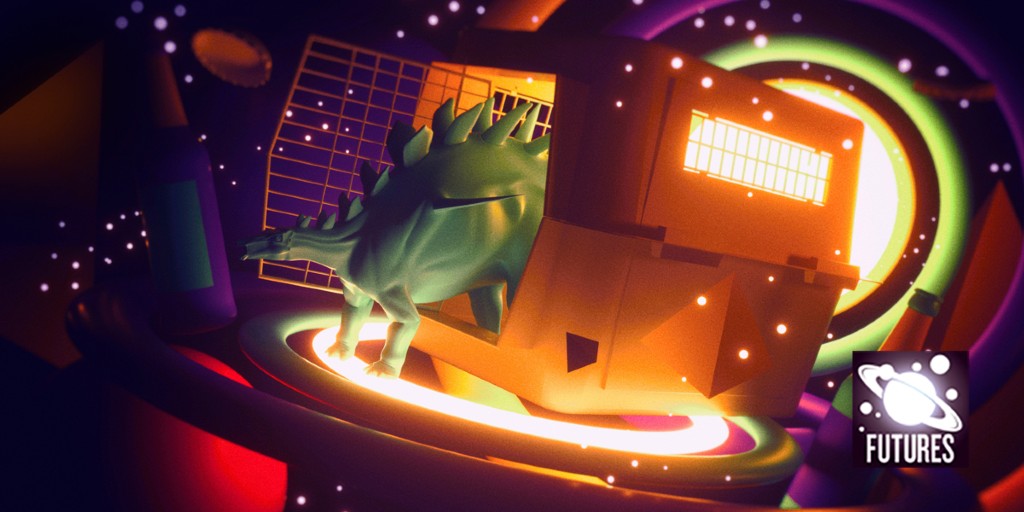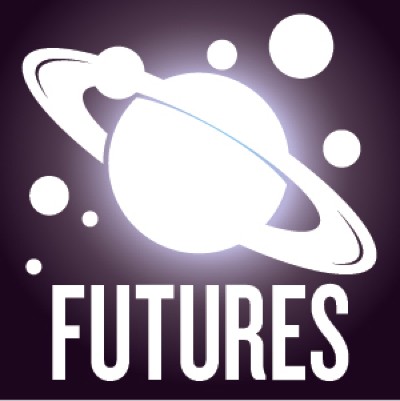The baby kentrosaurus bumps the gate of the pet carrier in the back of my SUV. It thwacks its spiked tail against the sides, grunts with what’s probably hunger, but what I can’t help thinking of as concern — like it senses my growing nervousness as I navigate the long driveway to my little sister’s house.
Funny how I think of her that way, even though she’s pushing 40 and a better physicist than I could ever hope to be. I used to think she squandered her potential walking away from the Probability Rift project — now I know it’s yet another example of her being the smarter sibling.
Kelleigh watches me approach from her front porch, posture like she should be holding a shotgun. It’s been six years since we talked, and I don’t know what I expected, exactly, but things change over time, right? Not long ago, attempting to smuggle even a tiny pull-through artefact from the Rift zone would have been impossible. Klaxons blaring; armed guards pouring from doorways; decontamination and imprisonment. These days, no one much cares.
“You dying?” Kelleigh asks when I exit the car.
It’s a tougher question than it should be. “Not at the moment.”
“Then why are you here?”
“Nice to see you, too,” I say. She raises an eyebrow. “It is,” I insist.
She regards me for a long, silent moment. “What — you want me to offer you a beer?”
I lift the pet carrier from the car. “I brought you a present.”
Jaded as she is, Kelleigh’s eyes goggle at the kentrosaurus even before I unlatch the carrier and it trundles out.
“Holy shit, you did it.” Her stare is split equally between me and the kentrosaurus. “Is that a stego — no, kentrosaurus, right? The shoulder spikes.”
“You always did know your dinosaurs. What other three-year-old wants to be a palaeontologist when she grows up?”
“Tons.”
“OK, but how many can pronounce it?”
She snorts. “How big do these get, anyway?”
Read more science fiction from Nature Futures
“About 18 feet long,” I say. “Dinosaurs are pretty recent target artefacts. We were focused elsewhere.”
Kelleigh’s house sits on I-don’t-know-how-many acres of Adirondack farmland, although she’s let it go to seed. Saplings grow along a meandering stream. Wildflowers paint swathes of the fields like a Monet.
She waves an arm at it. “It’ll have plenty of room to grow, I guess.” The first hint of a smile since I’ve arrived.
I grimace. “You probably don’t need to worry about that.”
Her smile falls. “It’s happened then?”
The Probability Rift was supposed to save the planet. The ability to reach into parallel universes, past and future timelines, far-off worlds, and retrieve information and resources. Targeting specific planets and times and universes to find what we needed to fix a dying Earth. Find a timeline that had discovered cold fusion and obtain the secret; remotely mine rare-earth minerals from an uninhabited planet as easily as sifting gold from a river; rewilding denuded biomes with animals from universes where humans took better care of the environment. Everyone admitted it seemed too good to be true, but the maths worked out. It couldn’t go wrong. Everyone involved in the project agreed.
Almost everyone agreed.
I nod to Kelleigh. “You told us so.”
“I knew you had an ulterior motive for coming here.” She stoops, strokes the kentrosaurus’s neck, hand zig-zagging between its bony plates. She stands, slaps her palms on her jeans, and says, “Alright, let’s see what I can do to help.”
When I don’t move to follow her into the house, she halts and quietly says, “That bad?”
I list a few of the bleed-through events: UFOs grounding air traffic over Reykjavik. Every bird at a Miami aviary turning to sand. Half a dozen new pyramids sprouting in the middle of the Sahara. Happening more frequently and over larger areas. Soon we won’t be able to hide them any more. People are going to learn that in trying to take only what we desired, we ripped holes between universes. Unwanted things are coming through, and the holes are growing and show no signs of stopping until our entire universe is one big expanse of nothing.
“How much time do we have left?” Kelleigh asks. “Before it all unravels?”
“We’re not sure,” I shrug. “Not long.”
“So this little guy is …?” She points to the kentrosaurus, which has wandered to a hobblebush shrub and is contentedly munching away.
“We pulled him through on purpose. A week or two ago. We hypothesized we might be able to repair our timeline with pieces of alternate universes. Plugging the holes. Papering them over, at least.” He’s also an apology for not listening, for letting my ambition break a friendship that had existed literally since Kelleigh was born.
“Not a terrible idea,” Kelleigh says, wheels turning. “Did you bring some reports, at least? Recent readings?”
I smile wryly and glance towards the car, where stacks of thick folders cover the back seat. “I might have a few.”
“He have a leash or something?” she asks about the kentrosaurus.
“I’ve got something in the car.”
“Well, alright.” She heads towards the house. “Get him tied up and get your files. I’ll grab us some beers.”
It’s too late. I know it, and I suspect Kelleigh does too. The Probability Rift shredded the Universe beyond repair. But maybe we can use what time is left to fix something else.








More News
US funders to tighten oversight of controversial ‘gain-of-function’ research
Bird flu in US cows: where will it end?
Daily briefing: Why exercise is good for us